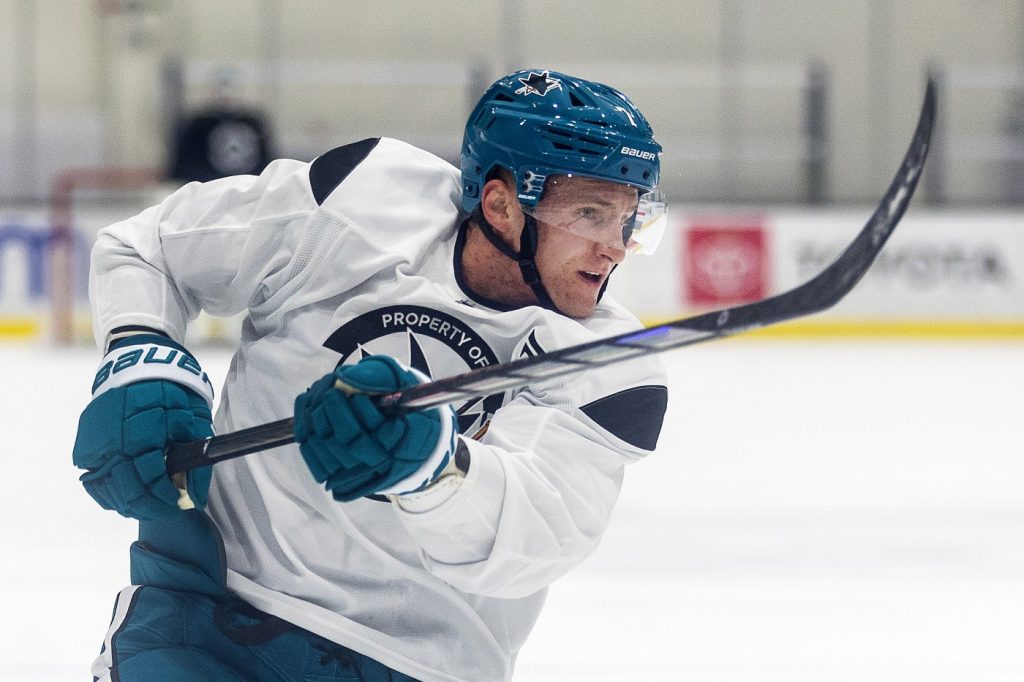SAN JOSE – San Jose Sharks forward Klim Kostin noticed at least one characteristic about most of the young players competing in this year’s training camp.
They’re all almost as big as him.
“I don’t know what they’re eating,” the 6-foot-4, 230-pound Kostin joked Friday.
Regardless of everyone’s diet, having some bigger bodies around Sharks Ice isn’t an accident.
Mike Grier said on the day he was officially introduced as the San Jose Sharks general manager just over two years ago that the team he inherited needed to add size up front and to the back end, while also becoming much harder to play against.
After three drafts and two seasons of roster churn, the Sharks appear to be a closer version of the team Grier envisioned.
Of the 62 skaters in camp this year, 29 are listed at being least 6-foot-2, and 33 weigh at least 200 pounds. At the start of camp three years ago, 22 were listed at 6-2, with only 23 over 200 pounds.
Tomas Hertl was one of the Sharks’ most physically imposing players at 6-3 and 215 pounds. He didn’t stand out the same way when he arrived in Las Vegas after the trade deadline.
“I was so used to being the tallest guy, and now I come here, and everybody is the same height or even taller,” Hertl said a week after the March 8 trade to the Golden Knights. “In the playoffs, when it matters, that’s a big thing. When you have good skill and powerful, big guys, I think in the playoffs, it really matters.”
While a majority of those big guys the Sharks had in camp three years ago never had sustained NHL careers, the Sharks, starting in 2022, have drafted six players in the first two rounds who are at least 6-2.
Five players, Filip Bystedt, Quentin Musty, Kasper Halttunen, Sam Dickinson, and Igor Chernyshov, are on the camp roster. Some of them could be in the lineup Sunday when the Sharks host the Golden Knights in the first preseason game. It is believed that Hertl will not be playing.
Part of Grier’s message to scouting department leaders Scott Fitzgerald and Chris Morehouse two years ago, according to Fitzgerald, was to “get some size in here, let’s get multiple picks, and let’s try to restock the cupboard.
“After two years, I think I’m biased, but I think we’ve done a good job here.”
The Sharks wanted to get bigger for obvious reasons: Heavy teams, as Hertl mentioned, usually enjoy more playoff success. Although Vegas lost to Dallas in the first round in April, recent Stanley Cup champions St. Louis, Tampa Bay, Vegas, and Florida played a skilled but heavy brand.
“Mike’s done a great job of bringing those players in and now drafting those players,” Sharks coach Ryan Warsofsky said of the added size in camp. “Obviously, you see in the National Hockey League, the teams in the finals are big, the defensemen are big, they’re heavy. So we’ve got to get there.
“We’re probably not there yet as an organization, but it’s definitely better than it was last year. So it’s a step in the right direction, for sure.”
San Jose Sharks center Luke Kunin, bottom, fights with Chicago Blackhawks center Andreas Athanasiou during the first period of an NHL hockey game in San Jose, Calif., Saturday, March 23, 2024. (AP Photo/Jeff Chiu)
It’s not just size, either. The Sharks agree that becoming a harder team to play against after allowing an NHL-worst 331 goals last season also involves playing with a certain mindset and attitude.
The Sharks brought back two-time Stanley Cup winner Barclay Goodrow, claiming him off waivers from the New York Rangers in June. Grier also acquired fellow no-nonsense forwards Ty Dellandrea and Carl Grundstrom in trades, adding to a second six that already included worker bees Nico Sturm and Luke Kunin.
“We got pushed around the last two years a little bit,” Sturm said. “Sometimes goalies will get clipped; guys get shoved around a little bit, and on the scoresheet getting bullied. Teams probably left those games a little bit too often against us, and they had way too much fun against us.
“And it’s not about size, or being 220 pounds, but it’s to be hard to play against. And what does that mean for me? It means that the team leaves the ice, and they say to themselves, that sucked. Playing against those guys tonight, that sucked. It was really hard. That’s where we’ve got to get to.”
“Obviously size helps. It’s always good to have size,” Kunin said. “But I think you’ve just got to have that competitiveness, that drive, that willingness just to do whatever it takes.”
Related Articles
Celebrini, Smith will face adversity as NHL rookies. Here’s why the Sharks aren’t worried
New-look Sharks want ‘to start writing their own history’
Grier stands by Couture with long-term playing outlook in question
Sharks’ prized young goalie injured as training camp opens
Sharks’ Couture attacks injury with rehab options: ‘Maybe something will click’
Six of the seven defensemen projected to be on the Sharks’ 23-man roster next month are 6-1 or taller and at least 205 pounds. Does that matter? Not as much as some other qualities, Mario Ferraro said.
“I think we need to get bigger in terms of our compete level and the way we battle out there, and our desire to win,” said Ferraro, who is listed at 5-11.
“I don’t think that size has anything to do with it. Obviously, if you want to be a more physical team, I guess. But I think overall, like from my perspective because I’m not an overly big guy and I’m a defenseman … is having a bigger heart, bigger compete, and that’s what we’re going to bring this year.”


